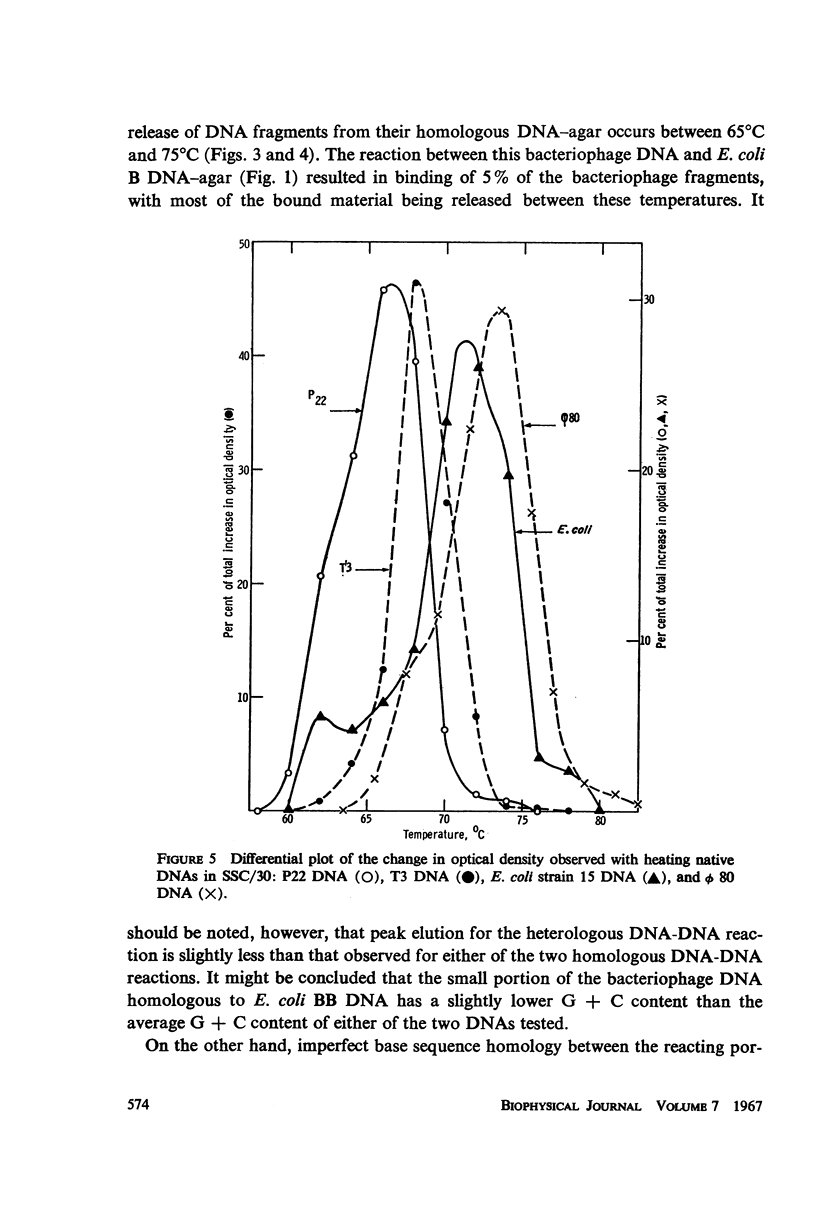Abstract
Genetic relationships among bacteriophages and bacteria have been investigated using an extension of the DNA-agar technique. Thermal elution profiles, each characteristic of a specific DNA-DNA reaction, have been obtained from reactions involving homologous and heterologous DNAs. A sizable portion of the DNA of lysogenic (or semilysogenic DNA) viruses has been shown to be homologous to the DNA of their bacterial hosts. These homologies are contained in numerous sequences throughout the viral DNAs. Furthermore, DNA homologies exist among most temperate phage DNAs as well as with their respective hosts.
Full text
PDF

















Selected References
These references are in PubMed. This may not be the complete list of references from this article.
- BOLTON E. T., McCARTHY B. J. A general method for the isolation of RNA complementary to DNA. Proc Natl Acad Sci U S A. 1962 Aug;48:1390–1397. doi: 10.1073/pnas.48.8.1390. [DOI] [PMC free article] [PubMed] [Google Scholar]
- BURGI E. Changes in molecular weight of DNA accompanying mutations in phage. Proc Natl Acad Sci U S A. 1963 Feb 15;49:151–155. doi: 10.1073/pnas.49.2.151. [DOI] [PMC free article] [PubMed] [Google Scholar]
- COWIE D. B., HERSHEY A. D. MULTIPLE SITES OF INTERACTION WITH HOST-CELL DNA IN THE DNA OF PHAGE LAMBDA. Proc Natl Acad Sci U S A. 1965 Jan;53:57–62. doi: 10.1073/pnas.53.1.57. [DOI] [PMC free article] [PubMed] [Google Scholar]
- COWIE D. B., MCCARTHY B. J. HOMOLOGY BETWEEN BACTERIOPHAGE LAMBDA DNA AND E. COLI DNA. Proc Natl Acad Sci U S A. 1963 Sep;50:537–543. doi: 10.1073/pnas.50.3.537. [DOI] [PMC free article] [PubMed] [Google Scholar]
- ENDO H., AYABE K., AMAKO K., TAKEYA K. INDUCIBLE PHAGE OF ESCHERICHIA COLI 15. Virology. 1965 Mar;25:469–471. doi: 10.1016/0042-6822(65)90067-x. [DOI] [PubMed] [Google Scholar]
- FRAMPTON E. W., BRINKLEY B. R. EVIDENCE OF LYSOGENY IN DERIVATIVES OF ESCHERICHIA COLI. J Bacteriol. 1965 Aug;90:446–452. doi: 10.1128/jb.90.2.446-452.1965. [DOI] [PMC free article] [PubMed] [Google Scholar]
- FRASER D. K. Host range mutants and semitemperate mutants of bacteriophage T3. Virology. 1957 Jun;3(3):527–553. doi: 10.1016/0042-6822(57)90008-9. [DOI] [PubMed] [Google Scholar]
- GREEN M. H. COMPLEMENTARITY BETWEEN LAMBDA (LAMBDA) PHAGE AND ESCHERICHIA COLI. Proc Natl Acad Sci U S A. 1963 Dec;50:1177–1184. doi: 10.1073/pnas.50.6.1177. [DOI] [PMC free article] [PubMed] [Google Scholar]
- Gelderman A. H., Lincoln T. L., Cowie D. B., Roberts R. B. A further correlation between the response of lysogenic bacteria and tumor cells to chemical agents. Proc Natl Acad Sci U S A. 1966 Feb;55(2):289–297. doi: 10.1073/pnas.55.2.289. [DOI] [PMC free article] [PubMed] [Google Scholar]
- KIGER J., GREEN M. H. THERMAL DISSOCIATION OF SYNTHETIC LAMBDA RNA-ESCHERICHIA COLI DNA HYBRIDS. Virology. 1964 Apr;22:602–607. doi: 10.1016/0042-6822(64)90082-0. [DOI] [PubMed] [Google Scholar]
- MCCARTHY B. J., HOYER B. H. IDENTITY OF DNA AND DIVERSITY OF MESSENGER RNA MOLECULES IN NORMAL MOUSE TISSUES. Proc Natl Acad Sci U S A. 1964 Oct;52:915–922. doi: 10.1073/pnas.52.4.915. [DOI] [PMC free article] [PubMed] [Google Scholar]


